Following The Leaders In St. Louis
March 8, 2012
 If you like awe-inspiring landmarks, civic pride, and professional baseball the odds of having a good time in St. Louis are in your favor. My trip last fall was a big hit in large part to Innovations in Textiles 9 (IT9), a biennial celebration of contemporary textile art that officially began September 17–18, 2011. Since 1991, scores of non-profit and private arts organizations, collectors, curators, and educators throughout the region have joined forces to promote exceptional fiber work by national and international artists through exhibitions, gallery tours, lectures, and workshops.
If you like awe-inspiring landmarks, civic pride, and professional baseball the odds of having a good time in St. Louis are in your favor. My trip last fall was a big hit in large part to Innovations in Textiles 9 (IT9), a biennial celebration of contemporary textile art that officially began September 17–18, 2011. Since 1991, scores of non-profit and private arts organizations, collectors, curators, and educators throughout the region have joined forces to promote exceptional fiber work by national and international artists through exhibitions, gallery tours, lectures, and workshops.
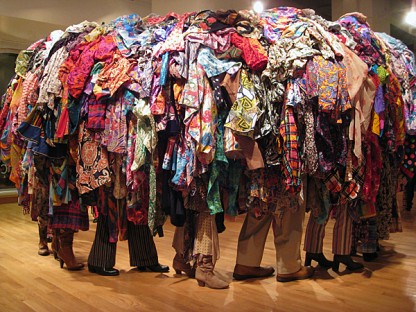 IT9 exhibitions took place at over 20 venues in the metro area. Catching all these shows was a cinch with guided gallery bus tours on September 17 and October 1. I tagged along on the former after giving the keynote lecture (titled Beyond Comfort) at the Missouri History Museum. My talk discussed the work of several artists who create innovative hybridized forms that expand the very definitions and boundaries of textile art. Citing recent examples by Cal Lane, Ligorano/Reese and Stephanie Liner (to name just a few), I posited the theory that artists today, often trained in more interdisciplinary and conceptually driven academic programs, are naturally more inclined to make hybridized art forms that exude an evolved fiber sensibility. Over the past decade artists working in all media have begun to embrace the ubiquitous nature of fiber materials and techniques for their vast emotional and symbolic potential.
IT9 exhibitions took place at over 20 venues in the metro area. Catching all these shows was a cinch with guided gallery bus tours on September 17 and October 1. I tagged along on the former after giving the keynote lecture (titled Beyond Comfort) at the Missouri History Museum. My talk discussed the work of several artists who create innovative hybridized forms that expand the very definitions and boundaries of textile art. Citing recent examples by Cal Lane, Ligorano/Reese and Stephanie Liner (to name just a few), I posited the theory that artists today, often trained in more interdisciplinary and conceptually driven academic programs, are naturally more inclined to make hybridized art forms that exude an evolved fiber sensibility. Over the past decade artists working in all media have begun to embrace the ubiquitous nature of fiber materials and techniques for their vast emotional and symbolic potential.
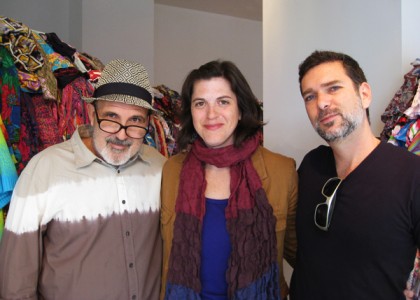 With thoughts of innovation and evolution swirling in the collective consciousness, we arrived at the Grand Center Gallery of Craft Alliance to see the humorous yet haunting Follow the Leader by Guerra de la Paz (GdlP). The charming Miami-based dynamic duo of Alain Guerra and Neraldo de la Paz created what appeared to be a deranged conga line with dozens of dancers frozen in time. GdlP created the site-specific installation with hundreds of pounds of discarded clothing and shoes. Inspired by the childhood game, destructive fashion industry practices and Darwin’s theory of natural selection, the psychedelic tableau captivated viewers with its camp and complexity. Like lemmings bumping and grinding their way off a cliff, this politically charged work playfully provoked a darker reconsideration of how we choose – and blindly follow – our leaders.
With thoughts of innovation and evolution swirling in the collective consciousness, we arrived at the Grand Center Gallery of Craft Alliance to see the humorous yet haunting Follow the Leader by Guerra de la Paz (GdlP). The charming Miami-based dynamic duo of Alain Guerra and Neraldo de la Paz created what appeared to be a deranged conga line with dozens of dancers frozen in time. GdlP created the site-specific installation with hundreds of pounds of discarded clothing and shoes. Inspired by the childhood game, destructive fashion industry practices and Darwin’s theory of natural selection, the psychedelic tableau captivated viewers with its camp and complexity. Like lemmings bumping and grinding their way off a cliff, this politically charged work playfully provoked a darker reconsideration of how we choose – and blindly follow – our leaders.
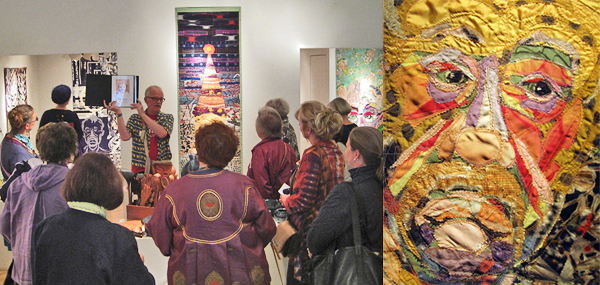 Craft Alliance’s Delmar Loop Gallery featured colorful self-portraits and narrative quilts by Japan-based SDA member Jim Hay and large-scale abstract sculptures made from found objects by Nigerian-American artist Nnenna Okore. Nearby Duane Reed Gallery presented mesmerizing wire mesh sculptures by Lanny Bergner (Anacortes, WA) and nostalgic Jacquard weavings of childhood dolls by Lia Cook (Berkeley, CA).
Craft Alliance’s Delmar Loop Gallery featured colorful self-portraits and narrative quilts by Japan-based SDA member Jim Hay and large-scale abstract sculptures made from found objects by Nigerian-American artist Nnenna Okore. Nearby Duane Reed Gallery presented mesmerizing wire mesh sculptures by Lanny Bergner (Anacortes, WA) and nostalgic Jacquard weavings of childhood dolls by Lia Cook (Berkeley, CA).
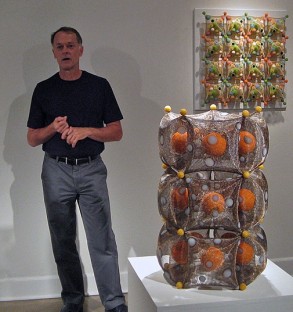 The volume of hometown talent on display was impressive but also uneven at times in scope and presentation. The innovative energy dipped at times when shows included pieces too provincial or too similar to those featured in earlier biennials. The paramount challenge of any regionally-focused arts event is to inspire the local community to create truly innovative new work, a goal IT9 sought to achieve in part through invitational opportunities with progressive visiting artists and curators.
The volume of hometown talent on display was impressive but also uneven at times in scope and presentation. The innovative energy dipped at times when shows included pieces too provincial or too similar to those featured in earlier biennials. The paramount challenge of any regionally-focused arts event is to inspire the local community to create truly innovative new work, a goal IT9 sought to achieve in part through invitational opportunities with progressive visiting artists and curators.
To this end Fiber Focus 2011 provided a must-see snapshot of Midwestern contemporary textile art. Internationally celebrated West Coast artist, educator and juror Lia Cook filled the cavernous gallery space at Art Saint Louis with her selection of 42 recent pieces from Arkansas, Illinois, Iowa, Kansas, Kentucky, Missouri, Nebraska, Oklahoma and Tennessee. The entry that most effectively captured the spirit of IT9 and won the Best of Show award (sponsored by Missouri Fiber Artists) was Remnants (2011) by University of Missouri—Columbia MFA student Trudy Rogers-Denham of Columbia, MO. This blanket-sized floor piece was composed of dirt intricately stenciled with an antique lace tablecloth. Its ephemeral nature and site-specific composition both attracted and repelled curious viewers. Symbolically it served as a potent reminder of how we, as a country, have had the metaphorical rug ripped out from under us to reveal the grime of greed and corruption swept beneath.
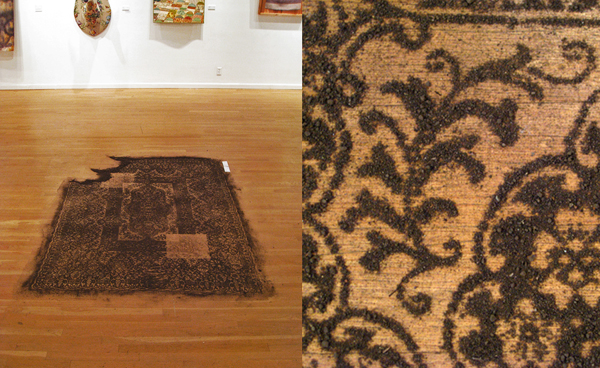 Teresa Paschke of Ames, IA received the 2nd place award for A.K. (2011), a digitally printed and hand-embroidered piece from a travel-inspired series that attracted attention during the 2011 SDA conference in Minneapolis. Jill Rumoshosky Werner of Wichita, KS took home the 3rd place award for her disconnected quilt composition Miscalculated (2009). Chicago-based emerging artist Aviva Alter provided evidence of less formal compulsions with Inside a Crowded Place and Winter Fragments 1 (both 2011). Oddly refreshing and a bit revolting, these abject departures from the norm were made of felted wool, gauze, wire, glue and hundreds of pins. The show also afforded opportunities to see exceptional works by many established artists like Shin-hee Chin (McPherson, KS) and Arturo Alonzo Sandoval (Lexington, KY).
Teresa Paschke of Ames, IA received the 2nd place award for A.K. (2011), a digitally printed and hand-embroidered piece from a travel-inspired series that attracted attention during the 2011 SDA conference in Minneapolis. Jill Rumoshosky Werner of Wichita, KS took home the 3rd place award for her disconnected quilt composition Miscalculated (2009). Chicago-based emerging artist Aviva Alter provided evidence of less formal compulsions with Inside a Crowded Place and Winter Fragments 1 (both 2011). Oddly refreshing and a bit revolting, these abject departures from the norm were made of felted wool, gauze, wire, glue and hundreds of pins. The show also afforded opportunities to see exceptional works by many established artists like Shin-hee Chin (McPherson, KS) and Arturo Alonzo Sandoval (Lexington, KY).
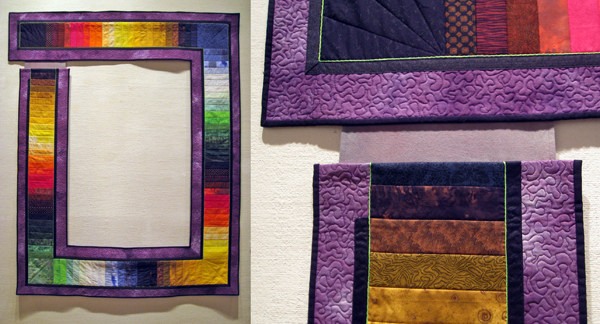
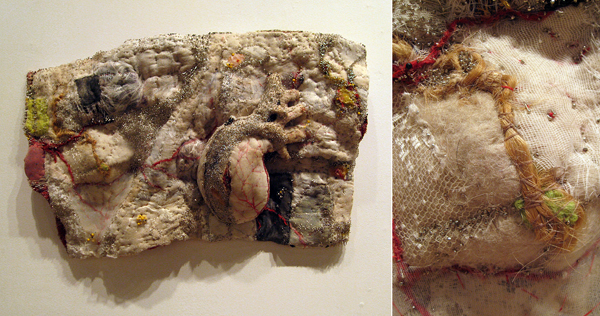
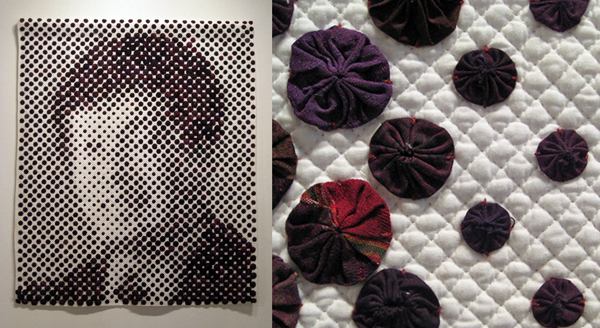
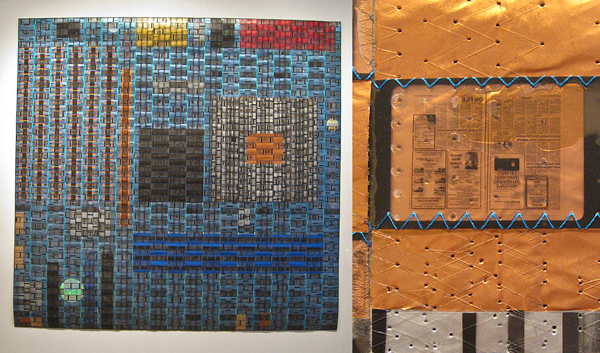
Venturing beyond the city limits, I was treated to an extra day of gallery hopping by my fabulous hostess Zoe Perkins (Textile Conservator, Saint Louis Art Museum). Our first stop in nearby Edwardsville, IL featured a sampling of recent textile pieces made by Southern Illinois University (SIUE) alumni at the Edwardsville Art Center. The selection, curated by artist and SIUE faculty member Laura Strand, offered a variety of fresh fiber forms including politically charged wearables by Bridget Kraft, handstitched photographic-print pieces by Luanne Rimel, dyed and felted wall works by Angela Perkinson, and a charming stampede of tiny bunnies made out of credit card junk mail by Christine Holtz.
The exhibit that felt the most communal and cohesive in its goal to create innovative new work was Collaboration: Reaping and Sewing at the Jacoby Art Center in nearby Alton, IL. Curated by participating artist, educator and blogger Patricia Vivod, this unique group show combined the textile-arts expertise and adventurous spirit of 6 friends who have influenced each other’s practices in teacher/mentor/student relationships. Erin Cork, Erin Vigneau Dimick, Nina Ganci, Jo Stealey, Laura Strand and Vivod selected 7 unfinished projects to be completed by others. The premise demanded an intense level of trust and commitment to on-going dialogue as each person sacrificed much-loved but languishing pieces of Jacquard-woven and shibori-dyed fabrics, vintage textiles and garments, handmade paper, found objects and other natural materials. In the curatorial statement Vivod writes: “This collective conversation has taken us out of our comfort zones to expand how we work conceptually, materially and how we think about our work.”
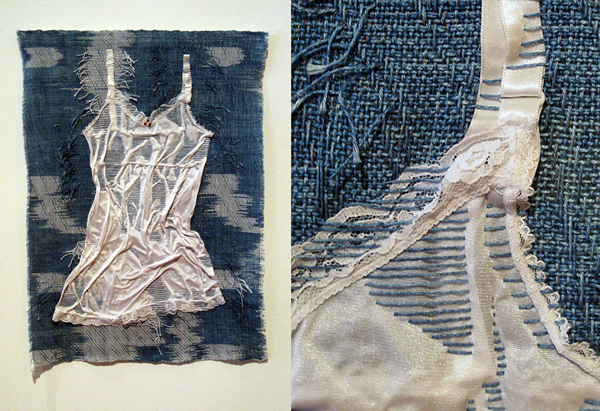 The resulting objects were both exceptional and unusual. While the majority were up-cycled with additional materials and techniques, others took a more deconstructive turn to reach their final destination. Erin Vigneau Dimick’s By Tradition Bound (2011) reveals a vintage slip trapped in the re-stitched surface of an indigo-dyed ikat textile. She combined newly learned dye and resist techniques with her own textile choices.
The resulting objects were both exceptional and unusual. While the majority were up-cycled with additional materials and techniques, others took a more deconstructive turn to reach their final destination. Erin Vigneau Dimick’s By Tradition Bound (2011) reveals a vintage slip trapped in the re-stitched surface of an indigo-dyed ikat textile. She combined newly learned dye and resist techniques with her own textile choices.
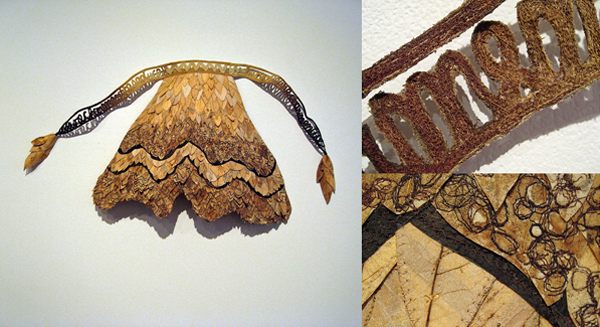 Following the garment thread, Jo Stealey created Ode to Susan (2011), a delicate apron made with processed leaves and cotton paper. The feminine mystique form features ties made of intricately machine-embroidered words like charm and entice to convey the often conflicting roles of wife and mother. When asked about the collaborative experience, Stealey reflects: “I believe all of us found this process very energizing. It pushed us beyond our current creative ruts. Although [there were] moments of paralysis as we digested the discussions about our work, we have all grown and evolved as artists.”
Following the garment thread, Jo Stealey created Ode to Susan (2011), a delicate apron made with processed leaves and cotton paper. The feminine mystique form features ties made of intricately machine-embroidered words like charm and entice to convey the often conflicting roles of wife and mother. When asked about the collaborative experience, Stealey reflects: “I believe all of us found this process very energizing. It pushed us beyond our current creative ruts. Although [there were] moments of paralysis as we digested the discussions about our work, we have all grown and evolved as artists.”
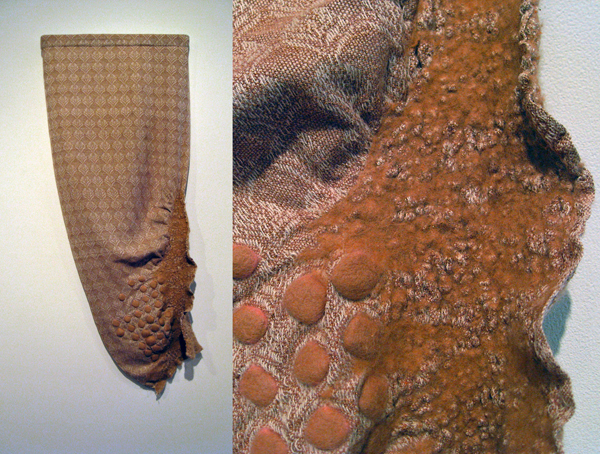 An unexpected favorite (impulsively added to my personal art collection) was Erin Cork’s Collaboration with Laura Strand (2011). Starting with a piece of Strand’s Jacquard-woven cotton fabric, Cork (a former SIUE student) needle felted flesh-colored wool into boil-like shapes along the bottom. Wet felting further distorted the traditional weave structure “infecting” it with a strange new conceptual agenda. Cork’s comical evolution of her mentor’s work offered an irresistible twist on the forward-thinking concept of innovation. Try as we may, teachers and mentors can nurture but never control the actions—or aesthetics—of our students. To an uncertain but always exciting extent, the future belongs to the next generation.
An unexpected favorite (impulsively added to my personal art collection) was Erin Cork’s Collaboration with Laura Strand (2011). Starting with a piece of Strand’s Jacquard-woven cotton fabric, Cork (a former SIUE student) needle felted flesh-colored wool into boil-like shapes along the bottom. Wet felting further distorted the traditional weave structure “infecting” it with a strange new conceptual agenda. Cork’s comical evolution of her mentor’s work offered an irresistible twist on the forward-thinking concept of innovation. Try as we may, teachers and mentors can nurture but never control the actions—or aesthetics—of our students. To an uncertain but always exciting extent, the future belongs to the next generation.
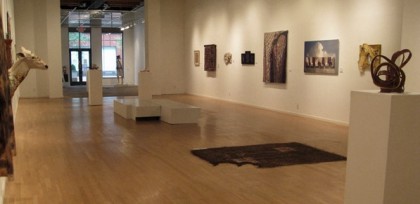 Before heading to St. Louis from my hometown of Portland, OR I enjoyed researching the exhibiting artists through IT9’s website, which provided information about and links to all of the events. Craft Alliance, Art Saint Louis, and Duane Reed Gallery all piqued my interest with images of works in progress and finished pieces on their websites and facebook.com pages. The smaller, volunteer-reliant spaces tended to provide only exhibition dates and artists’ names. For these less assertive galleries I encourage taking advantage of the many free and user-friendly online promotional tools available today through blogs, social networking and Flickr.com image galleries that can easily be linked to from existing webpages.
Before heading to St. Louis from my hometown of Portland, OR I enjoyed researching the exhibiting artists through IT9’s website, which provided information about and links to all of the events. Craft Alliance, Art Saint Louis, and Duane Reed Gallery all piqued my interest with images of works in progress and finished pieces on their websites and facebook.com pages. The smaller, volunteer-reliant spaces tended to provide only exhibition dates and artists’ names. For these less assertive galleries I encourage taking advantage of the many free and user-friendly online promotional tools available today through blogs, social networking and Flickr.com image galleries that can easily be linked to from existing webpages.
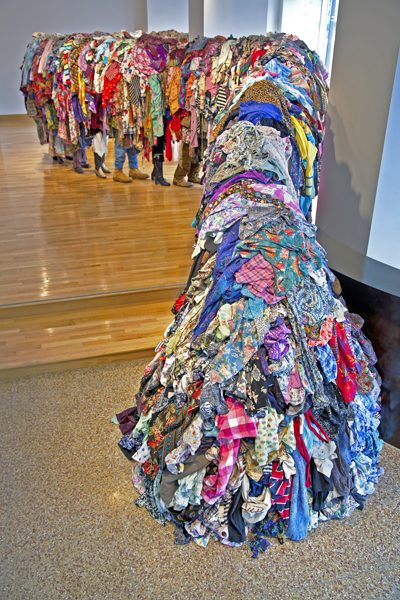 Online and in person, I look forward to seeing the next wave of innovative textile art on display at IT10 when I’ll be the juror for Fiber Focus 2013 at Art Saint Louis. I hope to see you there!
Online and in person, I look forward to seeing the next wave of innovative textile art on display at IT10 when I’ll be the juror for Fiber Focus 2013 at Art Saint Louis. I hope to see you there!
___________________________
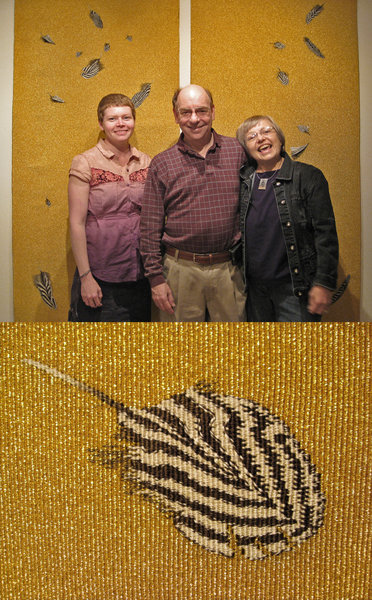 Marci Rae McDade is the new editor of Surface Design Journal and former editor of FiberArts magazine. She received an MFA in fiber and material studies from the School of the Art Institute of Chicago and a BA in film and video production from Columbia College Chicago. As a practicing fiber artist and independent curator, McDade has exhibited her own work nationally in solo and group shows and curated numerous contemporary art exhibitions over the past decade. She is currently a mentor in the Applied Craft & Design MFA program (cosponsored by OCAC and PNCA) in her hometown of Portland, OR. You can find her on Facebook and follow her on Twitter@marciraemcdade.
Marci Rae McDade is the new editor of Surface Design Journal and former editor of FiberArts magazine. She received an MFA in fiber and material studies from the School of the Art Institute of Chicago and a BA in film and video production from Columbia College Chicago. As a practicing fiber artist and independent curator, McDade has exhibited her own work nationally in solo and group shows and curated numerous contemporary art exhibitions over the past decade. She is currently a mentor in the Applied Craft & Design MFA program (cosponsored by OCAC and PNCA) in her hometown of Portland, OR. You can find her on Facebook and follow her on Twitter@marciraemcdade.
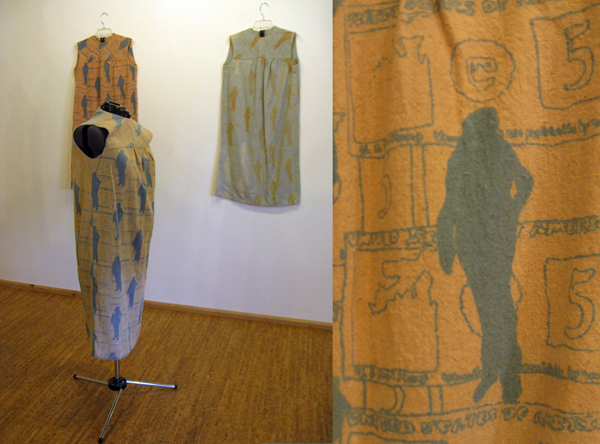
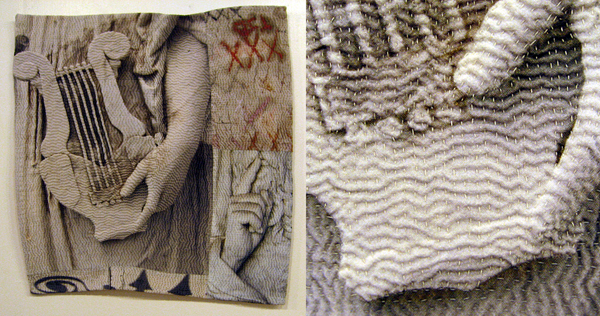
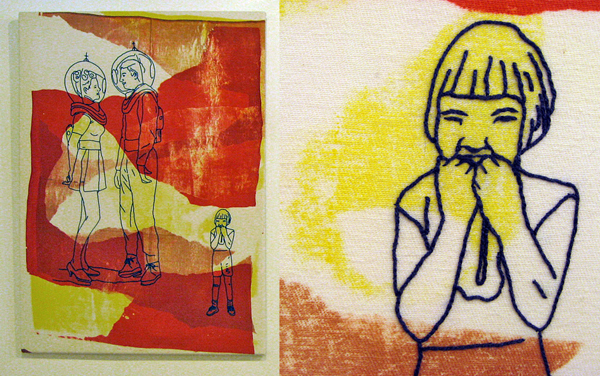
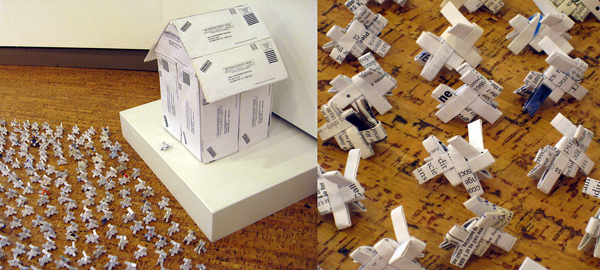


1 Comment
Giedra Dagiliene says
March 9, 2012 at 3:24 am
Very impressive arrangement, so many contemporary people are interested the teztile art
Related Blog Articles
Conferences
“Domestic Spaces” — Out Now!
Conferences
Friday Fibers Roundup: Tight-Knit
Conferences
Friday Fibers Roundup: Artistic Approaches